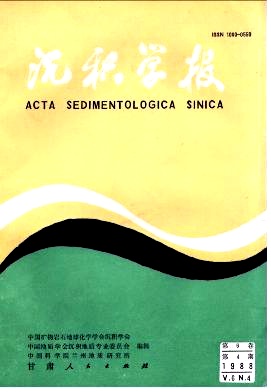MAMMIFORM STRUCTURE OF UPPER DEVONIANIN MUGUI, GUANGXI PROVINCE AND ITSGEOLOGICAL SIGNIFICANCE
- Received Date: 1986-08-05
- Publish Date: 1988-12-10
Abstract: Mammiform structure ( MS ) is a newly-discovered sedimentary structure in chert, stratiform barite and carbonate manganese ores in China. The most typical example is found in Mugui area in the 250m thick Upper Devonian cherts with intercalations of basic to acid subvolcanic rocks and red and green jasper and manganese ores.MS can be seen in the thin laminated chert layer near the bottom of the acid subvolcanic rocks.The relationship between chert stratification and the morphology of MS indicates a meta-synsedimentary origin before the chert was consolidated. Most MS looks like a upside-down mamma with a diameter of several centimeters and a hight to width ratio of 1-2. It has a convex rounded top surface which intercepts with the bottom at an angle of about 60° -90°. A little hole about several millimeters in diameter can be seen near the bottom. Different zones can be recognized in the cross section from its rim inwards: 1 ) The external zone ( e-zone) consists of mudquartz which is partially recry-stallied and replaced by micro-quartz Unchangen chert is common. In some cass-es residual stratification can be noticed in chert. 2 ) The internal zone ( f-zone ) is composed nearly completely of recrystal-lized chert with remarkable spherulits of fibrous quartz. 3 ) The core zone (g-zone) is characterized by crystallization and filling. It consists of micrograined quartzs and spherulite quartzs which are connected in the form of triple comjunction ( 120° ). Both the internal zone and the core zone are wider at the top and narrow down towards the bottom, matching the configuration of MS. Its apex points directly to the little hole at the bottom of MS. The mineral composition of MS and its country rock have been determined by X-ray diffraction. Quartz is found predominant with small amounts of illite,albite and gypsum. From the country rock to. the core of MS, quartz increases slightly while illite decreases. It is considered that MS has been originated from unconsolidated chert through alteration, filling and recrysiallization in response to a SiO2-rich hydrothermal solution. With decreasing hydrothermal activity, SiO2 will precipitate in the order of quartz vein→silicified rock→silica MS→jasper→stratiform chert. MS is a special type of siliceous sinter formed at pelagic or sub pelagic basin. In addition, MS has also been reported from barite, manganese ores as well as chert elsewhere. Therefore, in addition to siliceous MS there can also be barite MS. manganese MS and probably sulfide MS. In terms of morphology, MS is similar to some other sedimentary structures, such as pit and mound, spring pits, gas pits and mud pool. But no compositional variation has been obserbedin these structures. MS can be readily distinguished from the above structures in terms of its compssition, structure; texture and occurrence. MS may provide a structural criterion for hydrothermal sedimentation geological history. The morphology and internal structure of MS can be used to determinestratigraphic sequence on the outcrop. The commonly observed sphe rulites of hydrothermal sedimentation may be confused with radiolarian siliceous rocks in shape. Particular care should be taken to avoid mistakes. The existance of MS may help to shed light on the origin of chert, barite and some manganese ores.
| Citation: | Chen Xianpei, Chen Duofu. MAMMIFORM STRUCTURE OF UPPER DEVONIANIN MUGUI, GUANGXI PROVINCE AND ITSGEOLOGICAL SIGNIFICANCE[J]. Acta Sedimentologica Sinica, 1988, 6(4): 22-32. |






 DownLoad:
DownLoad: